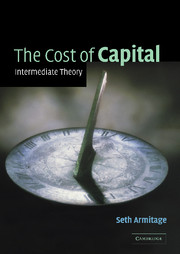Book contents
- Frontmatter
- Contents
- List of figures
- List of tables
- Preface
- Part I Expected Returns on Financial Assets
- Part II A Project's Cost of Capital
- 6 Project valuation
- 7 Corporation tax, leverage and the weighted average cost of capital
- 8 Personal tax and the cost of equity: the old and the new views
- 9 Personal tax, leverage and multiple tax rates
- 10 Inflation and risk premiums
- 11 The international dimension
- Part III Estimating the Cost of Capital
- References
- Index
9 - Personal tax, leverage and multiple tax rates
Published online by Cambridge University Press: 05 June 2012
- Frontmatter
- Contents
- List of figures
- List of tables
- Preface
- Part I Expected Returns on Financial Assets
- Part II A Project's Cost of Capital
- 6 Project valuation
- 7 Corporation tax, leverage and the weighted average cost of capital
- 8 Personal tax and the cost of equity: the old and the new views
- 9 Personal tax, leverage and multiple tax rates
- 10 Inflation and risk premiums
- 11 The international dimension
- Part III Estimating the Cost of Capital
- References
- Index
Summary
The previous chapter concentrated on the specification of the cost of equity allowing for personal tax, assuming that the income tax rate on dividends exceeds the effective CGT rate. It questioned whether the cost of equity for retained earnings should be viewed as the expected rate of return on a company's shares at their equilibrium market price. The current chapter leaves this question aside. Here we consider further the effects of personal taxes on the expected rates of return on equity and debt viewed as financial assets. The analyses allow personal tax rates to differ across investors, in certain ways, as well as across types of asset. We revisit the effect of leverage on the weighted average cost of capital, this time allowing for personal tax, and we consider the effect of an imputation system. The chapter ends with an introduction to the general problem of price setting in a market in which investors are heterogeneous with respect to the tax rates they face.
The notation is the same as in Chapter 8, except for the following variations. The differences between dividends and capital gains, and between share issues and retained earnings, are ignored. So there is now assumed to be a rate of personal tax on equity, TE, that is common across shareholders, and that could be zero (the α superscript for the pay-out ratio is dropped from TE). The symbol TI refers exclusively to the personal tax rate on interest in this chapter.
- Type
- Chapter
- Information
- The Cost of CapitalIntermediate Theory, pp. 205 - 224Publisher: Cambridge University PressPrint publication year: 2005



